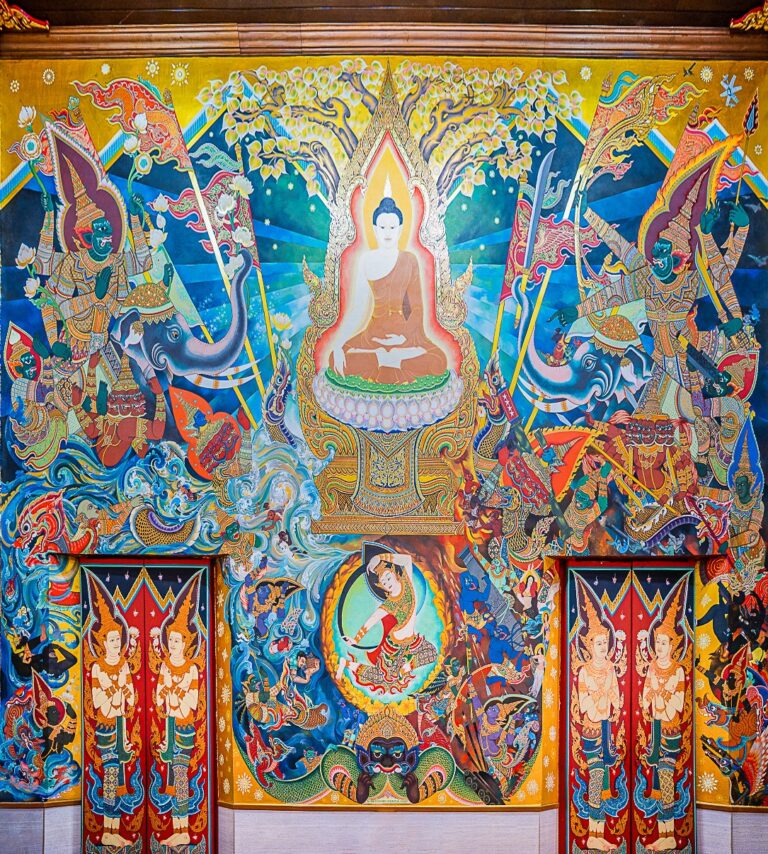
This painting depicts events immediately following the “The Golden Bowl” mural.
THE ASSAULT AND DEFEAT OF MARA
This painting depicts events immediately following the “The Golden Bowl” mural.
On the evening before his Enlightenment, Siddhattha Gotama, the future Buddha, sat cross-legged under the Bodhi tree, the Tree of Awakening. The evil demon Mara, the representation of evil and temptation, knew that Siddhattha Gotama was about to escape his control, so he summoned his army. He took on a terrifying many-armed form, and mounted a giant elephant named Girimekhala, or “Girded-with-mountains.” His army had ten battalions, representing the ten vices: lust, dissatisfaction, hunger and thirst, craving, sloth and torpor, cowardice and fear, doubt, conceit and ingratitude, undeserved fame, and disparaging others.
The mural illustrated Mara’s dancing daughters, representing three of the vices, in the mural “The Three Daughters of Mara.”
The gods in heaven had been singing the praises of the future Buddha, but when Mara’s army approached to do battle, they all ran away. Even the Serpent King fled underground and held his face in his hands, as seen in the bottom centre of the mural. Only the Bodhisatta remained seated.
The future Buddha saw Mara’s army approaching and knew he was alone. He decided to defend himself using the Ten Perfections: generosity (dāna), morality (sīla), renunciation (nekhamma), insight (pañña), energy (viriya), patience (khanti), truthfulness (sacca), resolution (adhiṭṭhāna), loving-kindness (metta), and equanimity (upekkhā). As Mara’s army of destruction and temptation approached, he sat and meditated upon them.
Mara caused a tornado, a typhoon, an avalanche, showers of hot coals and ash, a sandstorm, a mudslide, and complete darkness, but the Bodhisatta remained undisturbed. He and his army fired weapons of every kind, ancient and modern, at the future Buddha, but he was untouched. The ammunition magically turned into heavenly flowers around him.
Mara, frustrated, ordered the Bodhisatta to give up his throne, claiming it belonged to him, not Siddhattha Gotama. Siddhattha Gotama replied that Mara had done nothing to earn the throne, thus, it belonged to him, the future Buddha. Mara was so angry that he flung a sharp-edged discus at the Bodhisatta, whose meditations protected him again, and the discus turned into heavenly flowers.
Finally, Mara said that his army had witnessed all the donations he had given. He accused the Bodhisatta of not having given any donations. Siddhattha Gotama said he did not have mortal witnesses for his donations like Mara, but he had given seven hundred donations in his past life. He said that the earth itself would be his witness to these donations.
With that, the future Buddha reached down with his right hand and touched the earth with his middle finger. This touching-the-earth gesture, or mudra in the Māravijaya attitude, is popular in the iconography of the Gotama Buddha.
The many donative libations the Bodhisatta poured on the ground throughout his former existences became drops of water that trickled down onto Phra Mae Thorani, or “Holy Mother Earth.” She rose up from the ground and confirmed Siddhattha Gotama’s right to occupy the throne of wisdom. Phra Mae Thorani is seen wringing the water from her long hair, as she is often depicted in Theravada Buddhist art.
The Bodhisatta had given so much that the water created a flood that destroyed Mara’s army and left the Bodhisatta free to attain Enlightenment. The water symbolises the Bodhisatta’s perfection of generosity (dāna). The fierce elephant, Girimekhala, knelt down in front of Siddhattha Gotama. Lotus blossoms bloomed in the hands of the soldiers where before they had held weapons. Even Mara himself clasped his hands together in prayer as he retreated.
With that, the Bodhisatta entered into a deep meditation, during which he attained Enlightenment and became the Buddha. This momentous event marked the beginning of his journey as a teacher and spiritual guide, sharing the teachings of the Dharma with all those who sought to understand and achieve liberation from the cycle of rebirth.
From this point on, the Buddha spent the rest of his life travelling and teaching, spreading the message of the Four Noble Truths and the Eightfold Path, helping countless individuals to understand suffering and the path to enlightenment. His teachings continue to inspire and guide people to this day.